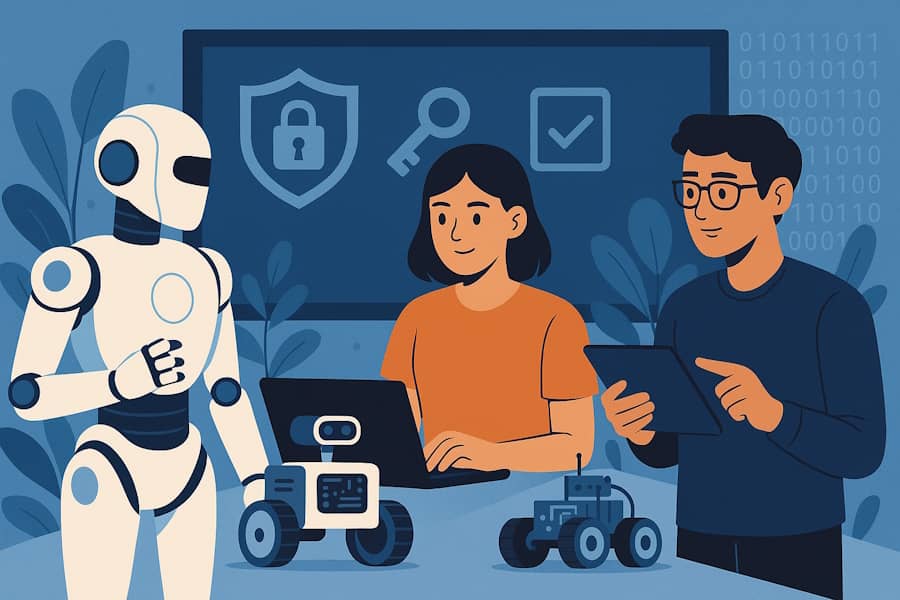The relationship between cybersecurity and robotics is growing stronger with every technological breakthrough. Students exploring robotics now find themselves learning how to protect the very systems they build. As robots become more connected, the need for defense against digital threats becomes essential. Educators are weaving cybersecurity principles into robotics lessons to prepare students for real-world challenges. This fusion of disciplines is changing how future engineers view technology and responsibility. It transforms robotics education into a foundation for secure innovation.
Cybersecurity training teaches students not just how to build, but also how to safeguard what they create. Robotics projects that include coding, sensors, and data analysis now require a layer of digital protection. This integration builds awareness about vulnerabilities that come with automation and AI. Students gain both technical confidence and ethical insight through this dual focus. The next generation of engineers must understand both construction and protection. This educational shift is reshaping how schools approach technology education worldwide.
The New Curriculum of Safe Engineering
Engineering programs that merge robotics and cybersecurity are redefining STEM learning. Educators are moving beyond mechanics and programming to teach students how to identify and fix system vulnerabilities. Security has become a fundamental design principle rather than an afterthought. Many institutions are incorporating modules that focus on ethical hacking, network defense, and secure coding. Such preparation is crucial as industries increasingly rely on automated solutions. Programs like engineering summer school often introduce these topics early, giving young learners a solid technical foundation.
Incorporating cybersecurity into robotics training changes how students think about engineering. They start viewing security as part of the creative process rather than a limitation. Lessons often involve real-world simulations where students must defend their robotic designs from cyberattacks. These experiences teach both problem-solving and resilience. Teachers encourage collaboration so students can analyze threats from multiple perspectives. Integrating cybersecurity also helps students appreciate the value of responsibility in technology. This mindset shift creates more well-rounded and socially conscious engineers. It also sets a new standard for innovation that prioritizes safety and integrity.
Learning in Tech-Driven Hubs
Cities known for innovation have become ideal environments for exploring the link between robotics and cybersecurity. In technology-focused schools, students experiment with connected devices, automation systems, and secure network programming. Educators encourage them to develop solutions that defend against unauthorized access or manipulation. Classrooms use project-based learning to show how small coding errors can lead to large vulnerabilities. Instructors emphasize the importance of secure software development for future robotics careers. This helps students see security not as a barrier but as a path to smarter designs. A summer school often serves as a model where such integrated education thrives.
The collaborative nature of robotics education also mirrors the teamwork required in cybersecurity. Students practice communication and analytical thinking while developing defensive protocols. They learn to anticipate risks before they become real problems. This combination of foresight and technical expertise strengthens their future readiness. Schools in tech-forward regions provide access to mentors who work in both fields. With each project, learners discover that a robot’s strength lies not just in what it can do, but in how safely it operates. This connection makes cybersecurity education indispensable to robotics learning.
Preparing Future Engineers for a Secure Digital Era
The intersection of robotics and cybersecurity offers students a competitive advantage in higher education and future careers. Instructors encourage experimentation while reinforcing awareness about system integrity. Students learn that even the most advanced robotics projects can be compromised without adequate protection. These skills have practical value across engineering disciplines. Programs such as Boston summer school often include introductory cybersecurity courses to spark early interest. Such early exposure helps students build curiosity and technical agility that lasts into college.
Preparing students for a secure technological future also involves fostering adaptability. Robotics projects evolve quickly, requiring learners to think critically about each line of code. When cybersecurity becomes part of this process, students are better equipped to handle unexpected challenges. The fusion of both subjects encourages hands-on learning supported by research and peer collaboration. Educators also emphasize the moral side of cyber protection, reminding students that safety extends beyond devices to human users. These discussions nurture empathy and accountability. This approach ensures that innovation grows responsibly within an interconnected world.
The Ethical Foundation of Digital Engineering
Cybersecurity education in robotics also nurtures a deep sense of ethics in technology. Students learn that creating powerful tools requires equal attention to safety and transparency. They are taught to evaluate the societal impact of their inventions before releasing them into the world. Robotics projects that consider privacy and user protection encourage trust between creators and communities. Courses emphasize data responsibility and informed decision-making. These lessons turn engineering students into thoughtful leaders who value both progress and protection. They recognize that ethical conduct is as vital as technical skill in shaping the future of automation.
Through projects that simulate real-world scenarios, students face challenges that test both their knowledge and integrity. They may design robots capable of gathering data but must also safeguard that information against misuse. This balance of innovation and restraint reflects the growing demands of the tech industry. Collaborative discussions help them understand how poor cybersecurity choices can lead to harmful outcomes. Educators encourage debate to reinforce moral reasoning within technical work. Students leave these programs aware that security failures can affect lives, not just machines. Such awareness defines the next generation of engineers who build with foresight and care.
Real-World Applications of Cybersecurity in Robotics
The partnership between cybersecurity and robotics now shapes real industries beyond academic projects. Students who understand both systems design technology that is safer and more reliable. This knowledge applies to fields where automation directly affects human lives and data security. Learning how to protect robotic systems ensures future engineers can handle both innovation and accountability. Below are examples that show where this combined expertise has the greatest impact.
Key Applications Where Cybersecurity Enhances Robotics:
- Healthcare: Medical robots must safeguard patient records and operational data from digital breaches. Secure programming prevents harmful interference during surgeries or monitoring.
- Autonomous Vehicles: Encryption and real-time security protocols protect self-driving cars from external manipulation. These measures ensure both public safety and system reliability.
- Industrial Automation: Protecting factory robots from malware keeps production steady and safe. Cyber-aware engineers maintain operational efficiency and worker trust.
- Agriculture: Smart farming robots rely on protected data to monitor crops and yields. Security protocols prevent data corruption that could harm productivity.
By applying cybersecurity to robotics, learners turn technical skill into responsible innovation. This connection strengthens industries and builds a foundation of safety for future technologies.
Final Thoughts
The growing integration of cybersecurity within robotics education is transforming how students approach engineering. It ensures that creativity aligns with accountability in an age defined by digital interconnection. Teaching these dual skills produces engineers who can design solutions that are both innovative and secure. Schools that blend robotics and security encourage students to question, test, and safeguard every idea they bring to life. The future of robotics depends not only on mechanical precision but on the trust it inspires. Cybersecurity provides that assurance, anchoring progress in responsibility.
Young learners who explore robotics through the lens of cybersecurity are shaping a safer technological world. Their awareness of system vulnerabilities builds resilience against future threats. Teachers who guide them through this process are redefining what it means to be an engineer. They are producing innovators who understand the value of caution as much as curiosity. Robotics and cybersecurity together redefine how the next generation will build the tools that drive human advancement. The collaboration between these fields ensures that progress remains both ambitious and secure. It is a partnership that safeguards innovation while inspiring continued exploration.








